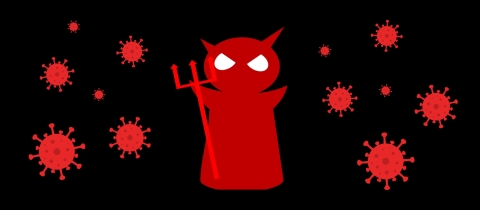If getting tested for cancer meant having a Labrador retriever sniff you for a few seconds, would it make the procedure more enjoyable? Just writing down this question, which has an obvious answer for me (yes!), made me think of reasons why this “pet scan” wouldn’t work for everyone. Some people are afraid of dogs. Some people are allergic to them. But what if instead of smelling you, they smelled a sample from you? The idea of dogs sniffing out disease (like COVID-19 more recently) is a topic that regularly grabs the headlines but which rarely gets the critical follow-up it deserves. Can dogs indeed detect illness in humans? Yes, they can, but before they can routinely be employed to do so, there are hurdles to clear and some argue these may be insurmountable.
A dog certainly has a leg up on humans when it comes to the sense of smell, with important genetic changes and a distinct anatomy allowing them to detect more scents than us and at lower concentrations. But even before our furry friends got involved in smelling sickness on us, we knew that certain disease states could produce a stink. Hippocrates in Ancient Greece was writing about changes in the odour of patients with a fever, but we had to wait until the late 1700s for one of the first attempts at analyzing human breath using modern scientific equipment to figure out what our exhales contained. Many of the molecules we breathe out and which play a role in disease detection research are called “volatile organic compounds” or VOCs. They are molecules that contain carbon atoms (the backbone of life as we know it) and that evaporate easily enough at room temperature to be detectable in air. The highest estimate I could find was 3,500 distinct VOCs in our breath (although many studies report much lower numbers). These VOCs end up in our exhalations through a variety of means. For example, acetone is generated by the bacteria in our body while propanol comes from rubbing alcohol and personal care products.
Breath analysis sans canine involvement is commonly used for very specific purposes. To help detect a bacterium responsible for stomach ulcers, patients can ingest radioactively-labelled urea which gets broken down into radioactively-labelled carbon dioxide that can be detected in the breath. Hydrogen, nitric oxide, and a few other molecules likewise play important roles in diagnostics. And of course, if you’ve ever been stopped by police on suspicions of driving under the influence, you know that your breath can reveal your intoxication.
Can dogs expand our repertoire of diagnostic “sniffology”?
Are you paw-sitive there is something wrong?
One of the earliest reports in the medical literature of a dog sniffing out disease was a short letter to the Lancet on April 1, 1989 (no joke). A 44-year-old woman became aware she had a skin cancer lesion because her dog would sniff at it and even tried to bite it off when she wore shorts. The tumour turned out to be malignant.
Researchers began to train and test a small number of dogs to detect specific types of cancer in specimens derived from people, like urine, sweat and breath. The setup is fairly simple. In a room, there is a big metal octopus with outstretched arms. At the end of each arm is a container. Inside the container is a sample. One of the samples is positive for cancer while the rest are negative controls. The dog comes inside the room and sniffs each container. To make the cancer specimen more enticing, a bit of dog food is hidden next to it. When the dog sniffs out this sample, they are rewarded and led out of the room. The process is repeated many times as the food gets removed and the experimenters become blinded to which sample is which. Eventually, a dog is trained which can, theoretically, sniff out a particular type of cancer in a particular type of sample. But can this dog compete with a machine?
How good a dog is at correctly identifying disease when it is there and appropriately not flagging patients when disease is absent (what are called “sensitivity” and “specificity”) varies a lot. In fact, many studies and reviews of studies point out the variation between breeds, within breeds, and between individual dogs... even for dogs similarly trained by the same institution. This variation means a dog is not as reliable as they should be. Then there is the issue of concentration. When testing a single dog which had been trained to sniff out a hospital-acquired infection by C. difficile, the authors of the study noted that their beagle got clearly distracted by “unrelated stimuli” (a life-size gorilla balloon among other things, I am told): in fact, a visit to the paediatric ward was deemed unusable because the children got excited and got the dog sidetracked.
Some pooches get trained as diabetes alert dogs with the goal of warning their owner of low or high blood sugar. What the dogs are actually detecting is unclear: it could be elevated levels of a molecule called isoprene in the breath or it could even be muscular tremors in their owners. And while the presence of these dogs can increase quality of life and ease the burden of living with diabetes, their reliability at flagging hypoglycaemia is questionable. In a study of 14 such dogs, only three performed statistically better than chance. The owners of these dogs may beg to differ but yet another study casts a shadow on their testimonies. The ability of this set of eight diabetes alert dogs to spot low blood sugar was quite poor and led to an average of 14.5 false alerts per week, but the owners subjectively reported an “overly optimistic and discordant” assessment of how good their dog was. Recall bias is surely to blame, but there’s another issue which brings to mind psychics: what constitutes an “alert” on the part of the dog is open to wide interpretation. An alert can be bringing a medical kit over, but it can also be barking, licking, nudging, making intense eye contact, nuzzling, jumping, yawning, scratching, or hiccupping. Basically, being a dog.
Dogs don’t come with standard operating procedures
Even if dogs reliably excelled at being bedside doctors, they are not machines. “Animals are not easy to ‘manufacture’ at large scale, ‘train’, ‘standardize’ and ‘regulate’,” doctor Madhukar Pai from our university told me on this subject. He is the director of the McGill International Tuberculosis Centre and he has written critically about, among other things, the use of African giant pouched rats to sniff out tuberculosis in the sputum of people. Training animals is expensive, time-consuming, not easily scalable and it has to be maintained so that the dog doesn’t lose their ability. Keeping a small army of dogs to detect each type of illness is impractical. Plus, animals have bad days. A dog with a respiratory illness can’t do its job. A dog can even carry infections and transmit them to humans. And what if a dog bites someone in the hospital while on C. difficile detection duty? We may be barking up the wrong tree by pushing for animals to act as diagnostic tools for us.
What dogs and other animals can be, however, is a furry proof of concept: certain diseases can be detected by odour alone. We should identify what these volatile molecules are and build machines to reliably detect them. Research into such “electronic noses” has been on-going for decades and has been beset by its own challenges. There is a lack of standardization in the collection of the precious samples and their analysis. But at least machines can be manufactured, regulated and controlled for their quality.
So as we get hit with more headlines of pooches being trained to pick up on the scent of COVID-19, you’ll have to pardon me if I think the promises they make don’t pass the sniff test.
Take-home message:
- The human breath contains many molecules that seem to be associated with different diseases
- Dogs have been trained to sniff out specific diseases in humans, like diabetes and certain types of cancer, but when they are properly tested, they turn out not to be very reliable
- Given that dogs cannot be manufactured and standardized, they can act as proof of concept for the development of “electronic noses” that could one day reliably sniff out human diseases







